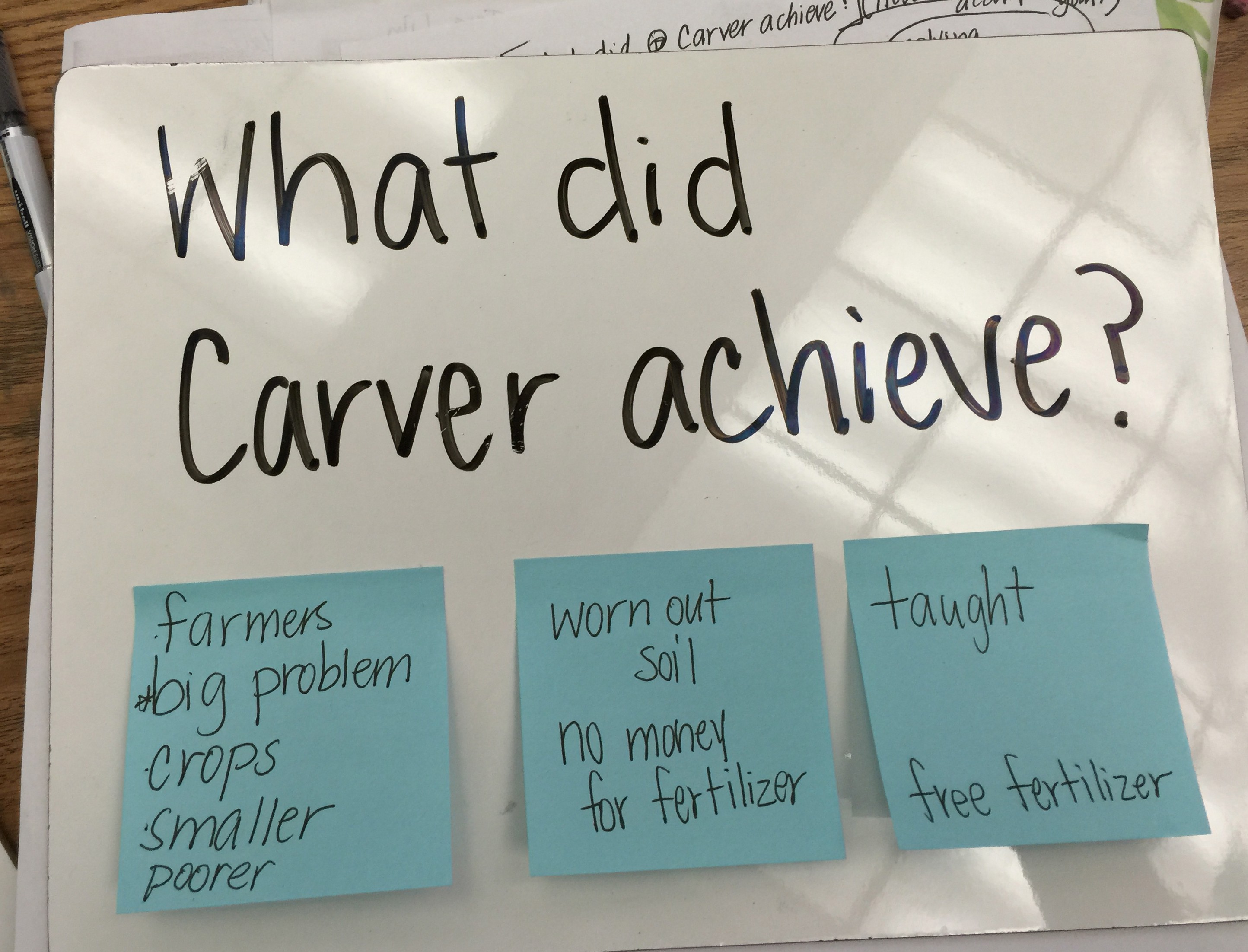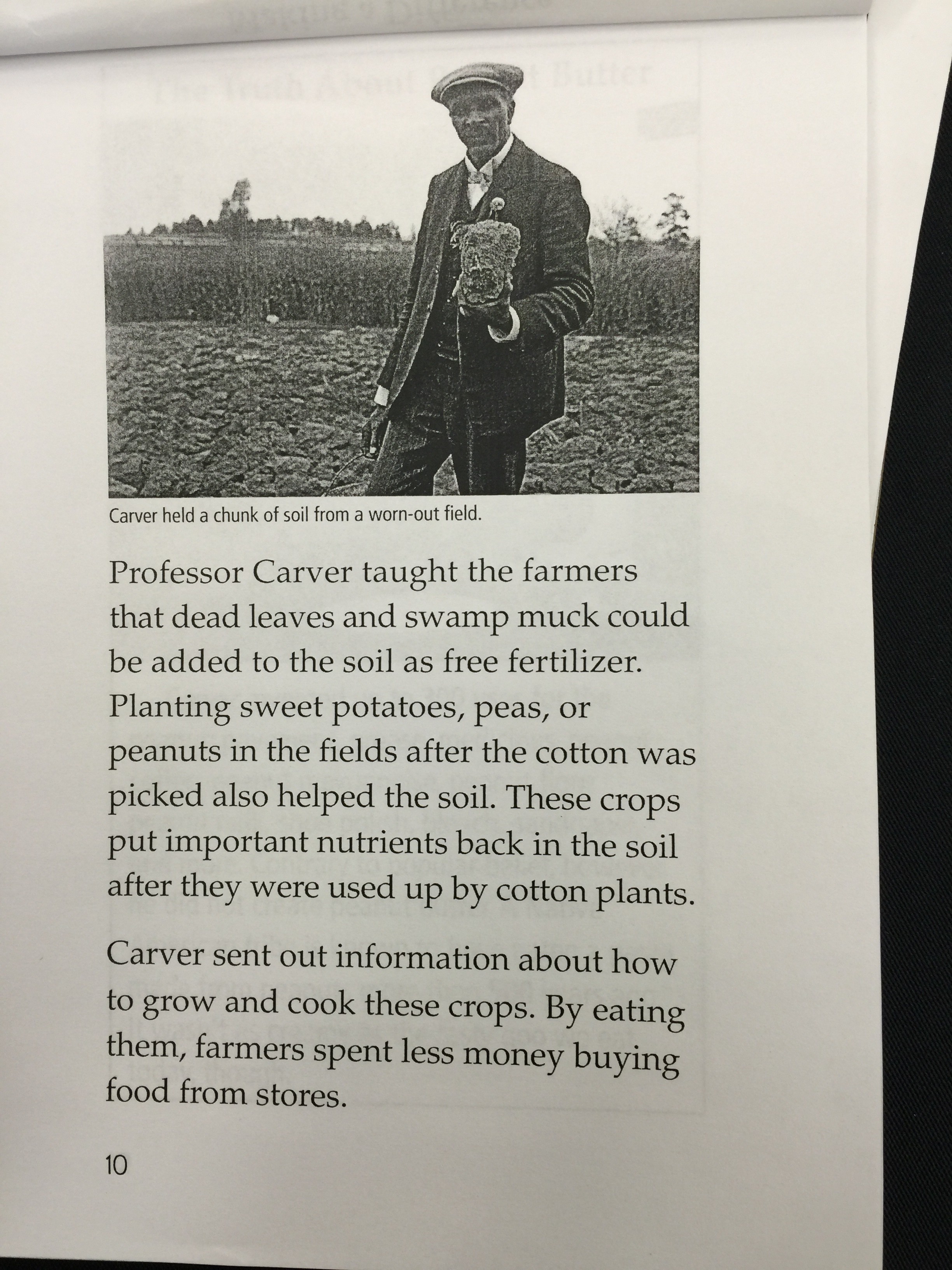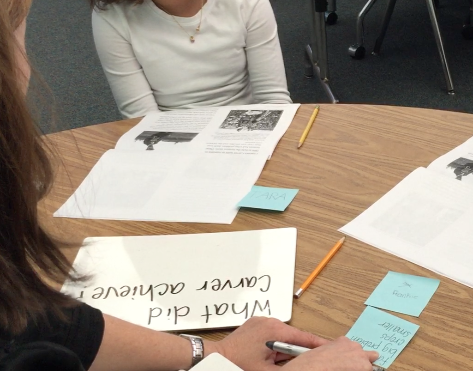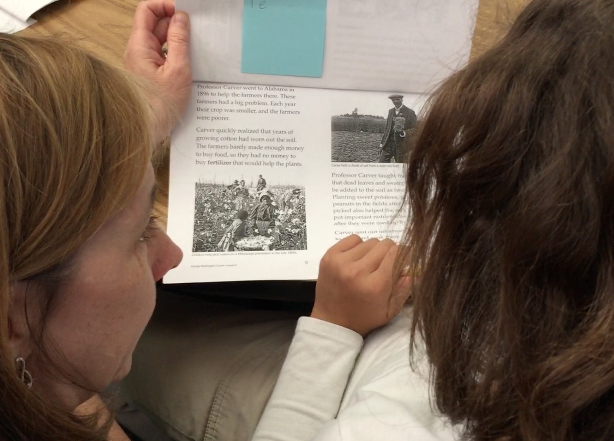
Last week I gave a close reading lesson with an excerpt from an A to Z text, George Washington Carver, written at Level O. (See my previous post “Tips for using A to Z texts for close reading”.) Our text-dependent question was, “What did Carver achieve?” This seems like an easy question at first, but the excerpt we chose offered multiple ideas that needed to be synthesized in order to respond to this question. See images of the two pages of text below.


Notice that in the first two paragraphs, the author describes the problems the farmers in Alabama faced in 1896. The details in these two paragraphs are important because they develop the challenge that Carver was facing as he endeavored to help these people. Quite often when we talk about the achievement of historical figures, we start with the achievement like “Carver helped the farmers.” A more rigorous approach is to think about achievement as signaling some sort of challenge to overcome and a great deal of hard work before the end result or achievement. For some students identifying an “achievement” like “Carver graduated from college” or “Carver helped the farmers” is too easy. I want them to grapple with the difficulty of this achievement, you know? When planning for teaching with this text, for me, key words to note included:
- Alabama, 1896
- farmers
- big problem
- crops smaller
- cotton
- worn out soil
- barely money for food
- no money for fertilizer
The last two paragraphs describe how Carver helped the farmers; the reader has to infer that he is helping them—through teaching and disseminating critical information. Key words to note include:
- taught
- dead leaves, swamp muck
- free fertilizer
- crops (like sweet potatoes)
- put nutrients back in soil
- sent out information about how to grow and cook
This was a maxi-guided reading–meaning it should have occurred over two lessons :)–with 2nd grade students. Here’s an outline of what I tried…
1. Briefly introduced the text (less than one minute). The students had already read the whole text once during a previous lesson with their teacher.
2. Explicitly taught the word crop and asked partners to define and explain (1 minute). When the students had read this during the previous lesson, the teacher and I noticed they’d struggled with this concept and it was crucial that they understand what crops are to get the meaning of this passage. I defined crops as “plants that are grown on purpose for food.” (I could have defined further, but I didn’t want to overwhelm the students.) We named aloud several crops–wheat, carrots, strawberries, and then I held up two fingers and told the students that when a farmer grows crops, they can 1) sell the crops for money or 2) keep the crops for food or other things they need. I asked the students to turn to a partner and describe what a crop was and two reasons farmers grew crops.
3. Presented text-dependent question and definition of “achievement,” read aloud definition, engaged in shared reading of definition and then discussion (1-2 minutes). I started the lesson by reviewing and clarifying the definition of achievement (which they’d been studying as part of a whole group unit of study with their classroom teacher). My definition for achievement was “a successful result brought about hard work”; as the students and I discussed this definition, I drew a box around “hard work” to emphasize this aspect of the definition and also added the words “difficult” and “problem.” See image below. By doing this, I’ve given the children vocabulary to articulate what they are noticing/comprehending as they engage in close reading to answer the question, “What did Carver achieve?”

3. Asked the students to read the text excerpt to themselves and conferred with individuals (3 minutes). I wanted the students to get the gist of the whole passage before we started dissecting it; so I started by asking them to read the whole excerpt to make sense of it for themselves. I was also concerned that the students would not understand the sentence at the end of the first paragraph: “Each year their crops were smaller, and the farmers were poorer.” This is a hard sentence because the reader has to know that the farmers need larger crops to sell and eat and they have to infer that if the farmers have smaller crops, they won’t have enough to eat or sell and they’ll be “poor” as a result. We could have just done a close reading and discussion on this one sentence!!!
4. Then I modeled with a think aloud how I would determine what was important in the first sentence and drew the students into thinking with me to identify key words on a sticky note (3 minutes). I was very clear about what a “key word” was for that particular lesson–any words (details) that help us think about Carver’s achievement. In this first paragraph, there’s a clear problem or difficulty. As we listed the words, I made it clear to students that these key words helped me think about what the “problem” was and what might be “difficult” – referring back to the dry erase board with the definition of achievement.

Notice I didn’t use all the key words I’d planned to use –it just works out that way sometimes. Looking back, I wished I’d included the “where” (Alabama) and the “when” (1896).
5. We stopped and used the key words on the sticky note to summarize aloud what we had just learned from the text (2 minutes). I coached volunteers in creating sentences like, “The farmers had a big problem because their crops were getting smaller and they were getting poorer.” I encouraged students to add interpretation to their summaries like, “They were getting poorer because they didn’t have enough crops to sell or eat.” (THIS WAS SO HARD for them!)

6. Then I asked them to read the next paragraph (2 sentences) on their own and to start their own list (on a sticky note) of key words that would help them answer the question, “What did Carver achieve?” I had time to confer with two students individually. (2-3 minutes)

7. We regrouped and used their key words as we discussed and then also to summarize aloud what they’d just read (2 minutes). I asked them to summarize from the beginning of the passage – so starting with the list we wrote together and then moving to the list they’d made.
NOTE: I should have stopped here, but I was having such a good time 🙂 and I had the luxurious option, as the visiting consultant, to extend the lesson time.
8. I coached the students in working their way through the next two paragraphs – asking them to read and write key words for a chunk at a time and then conferring with them (5 minutes).
9. We closed by using the key details we’d written on sticky notes to summarize aloud what we’d learned (in response to the question, “What did Carver achieve?) with a partner (1 minute).
In the image below, I’m coaching partners in using key words one of the students had listed. This continuous routine of returning to our key words and summarizing aloud is HUGE–as you’ll see in the next lesson I taught with them.

What was BIG for me in this lesson –
- the power of a text-dependent question with well defined vocabulary;
- teaching critical concepts like “crops” – quickly and clearly in a way that children can grasp and return to easily when they have questions;
- conferring with individuals to see where things are “clicking or falling apart” (like some struggled with the idea of “crops got smaller and farmers got poorer” and needed a one-to-one discussion around this idea);
- listing “key words that help us answer our question” – students can become overwhelmed by “What is a key word?” so I try to make it very clear what a “key word” is during a particular lesson and, in this case, key words were details that help us think about how to answer the question, “What did Carver achieve?”
- using the key words to summarize aloud–after each chunk of reading (which might be a paragraph or just a sentence or two).
LUCKY ME!!! I had the privilege of teaching this group on a second day – we used the key words they wrote to write a response to the question. Stay tuned for my next blog post!!!!
Seriously – hope this helps.
S
